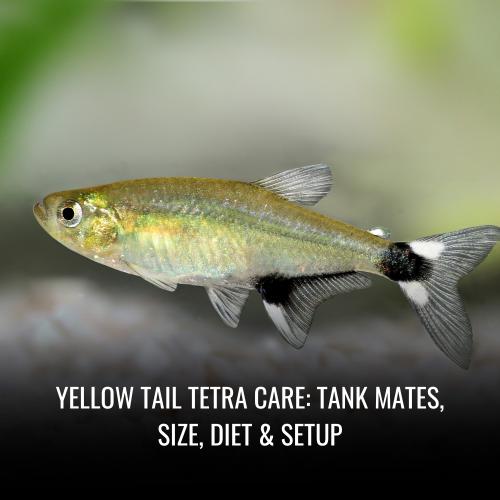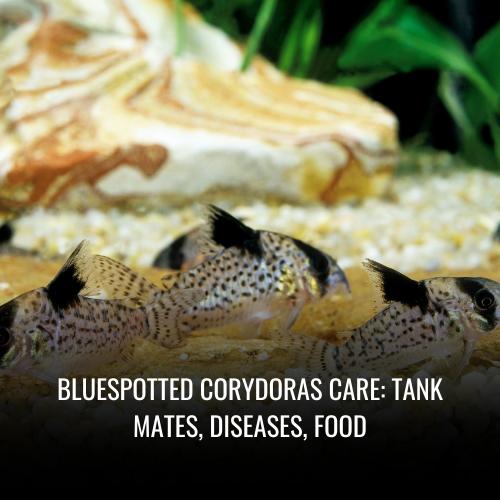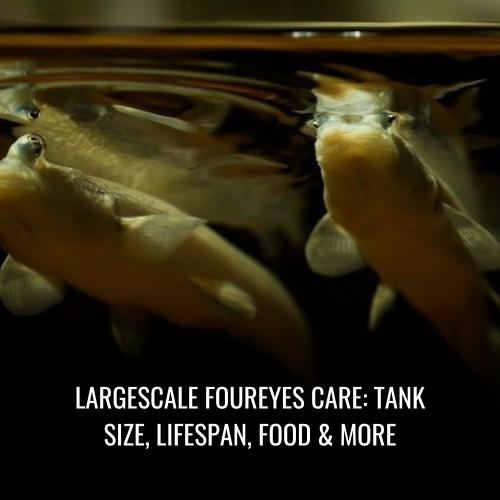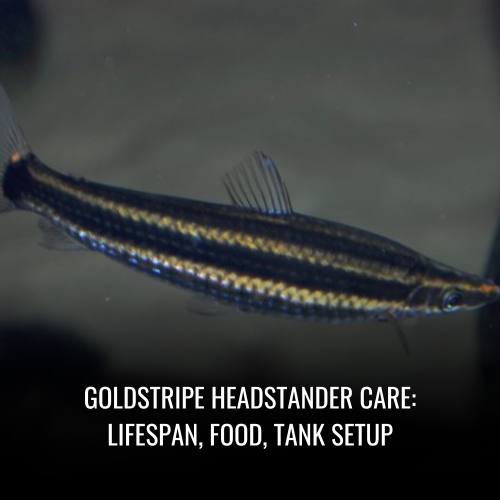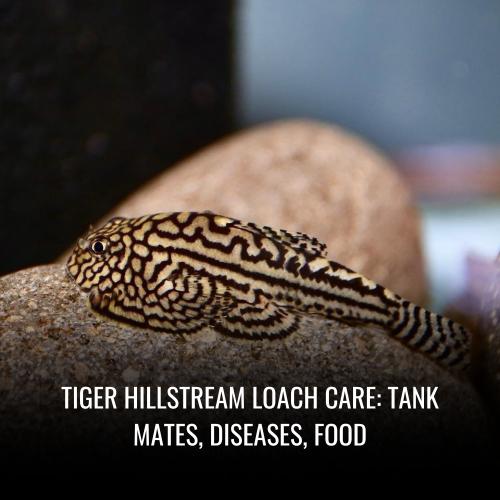Flagtail catfish Care: Tank Size, Lifespan, Food & More
This post contains affiliate links. As an Amazon Associate, we earn from qualifying purchases.
The Flagtail Catfish, also named as Flagtail Porthole Catfish, is a tropical freshwater fish admired by enthusiasts for its unique tail pattern and peaceful demeanor. Originating from the Amazon River, this member of the Callichthyinae sub-family thrives in aquarium settings that replicate the varied conditions of shallow waters during wet and dry seasons.
For those looking to add these graceful swimmers to their community aquarium, maintaining appropriate water conditions — from pH to hardness — is vital for their health and vitality.
Here’s a succinct table encapsulating the essentials for Flagtail Catfish care:
| Attribute | Detail |
|---|---|
| Scientific Name | Dianema urostriatum |
| Common Names | Flagtail Catfish, Flagtail Porthole Catfish |
| Family | Callichthyidae |
| Usual Size in Tanks | Up to 3.5 inches (9 cm) |
| Recommended pH Range | 6.0 – 7.5 |
| Recommended Hardness (dGH) | 5 – 19 |
| Recommended Temperature | 73°F – 79°F (23°C – 26°C) |
| Reproduction | Egg layer |
| Origin | Amazon River Basin, South America |
| Temperament to Own Species | Peaceful |
| Temperament to Other Species | Generally Peaceful |
| Usual Place in Tank | Bottom |
| Lifespan | 5 years or more |
| Tank Size Requirement | Minimum 30 gallons |
| Filtration System | Moderate, with gentle water flow |
| Sexual Dimorphism | Not easily distinguished |
| Substrate Cleaning | Substrate sifter, aids in tank cleanliness |
A well-cared-for Flagtail Catfish, with a balanced diet and harmonious tank mates, can be an entertaining and lasting addition to any aquatic community, entrancing hobbyists for decades with its unique characteristics and lifestyle.
**Please note that although this fish is known to be peaceful, it is essential to always observe individual behaviors, as temperament can vary.
Scientific Name
The Flagtail Catfish, scientifically known as Dianema urostriatum, is a captivating tropical fish with a rich heritage within the aquarium trade. This species falls under the order Actinopterygii, which represents the largest class of fish, the ray-finned fishes. Classifying further, the Flagtail Catfish is a part of the family Callichthyidae, a group renowned for what is commonly referred to as armored catfishes.
Originally from Brazil, this intriguing fish was first described in 1912, and over time, it has become known by several common names. In addition to its scientific moniker, Dianema urostriatum, it is often referred to as the Flagtail Porthole Catfish or the Stripedtail Catfish due to its distinctive tail markings.
Below is a concise table highlighting this catfish’s scientific classification:
| Classification Level | Scientific Name |
|---|---|
| Order | Actinopterygii |
| Family | Callichthyidae |
| Genus | Dianema |
| Species | Dianema urostriatum |
The simplicity of the Flagtail Catfish’s scientific name, paired with its notable features, aids in better understanding and discussing this tranquil yet visually striking aquatic species.
Average Size
The Flagtail Catfish offers a range of sizes suitable for many home aquariums. On average, hobbyists can expect their Flagtail Catfish to grow up to 3.5 inches (9 cm). However, in captive environments like fish tanks, they commonly measure between 4.33 and 5.12 inches (11 – 13 cm), providing a substantively visible presence.
Upon purchase, the usual arrival size of a porthole flagtail catfish is around 3-4 inches. This size may fluctuate slightly based on the stock at the time of acquisition, but they typically reach an adult size of 4-5 inches. For enthusiasts looking for variety, there is also the Albino Marbled Hoplo Catfish, which is a bit smaller, averaging between 1 to 2 inches.
Here’s a concise table summarizing the size ranges:
| Catfish Type | Average Size (inches) | Average Size (cm) |
|---|---|---|
| Flagtail Catfish | 3.5 | 9 |
| Fish Tank Flagtail Catfish | 4.33 – 5.12 | 11 – 13 |
| Arrival Size (Porthole) | 3 – 4 | |
| Adult Size (Porthole) | 4 – 5 | |
| Albino Marbled Hoplo | 1 – 2 |
The Flagtail Catfish’s moderate size makes it an attractive choice for those maintaining a community aquarium with other peaceful fish. Its size also necessitates attention to tank conditions, diet, and room for growth.
Lifespan
The Flagtail Catfish, or Dianema urostriatum, is not only popular for its striking appearance but also its notable longevity. In home aquariums, with diligent care, these tranquil tropical freshwater fish can live up to a decade. This lifespan aligns with their longevity in the wild, marking them as a long-lived species within their natural Amazon River basin ecosystem.
Aquarists who invest in the care of Flagtail Catfish are often rewarded with a companion for many years. Accurate water conditions, a suitable and varied diet, along with the proper water hardness and pH levels, contribute to the health and longevity of these fish. Understanding their need for a harmonious environment can make a drastic difference, ensuring they thrive for the duration of their potential lifespan.
Here’s a short list showcasing the Flagtail Catfish’s lifespan facts:
- Expected lifespan under proper care: Up to 10 years
- Comparison: Longer-lived than many freshwater fish
- Lifespan consistency: Same expectancy in the wild and in captivity
- Care factors: Tank environment, diet, water parameters
Responsible aquarium enthusiasts recognize the commitment of keeping Flagtail Catfish and the gratification of fostering them through a full, healthy life cycle.
Natural Habitat
Nestled within the tranquil waters of Brazil’s Amazon River basins, the Flagtail Catfish finds its serene sanctuary. The peaceful tributaries, backwaters, and hidden lakes of the region serve as an idyllic backdrop for this tropical freshwater fish. Far from the aggressive species that dominate other parts of the Amazon, the Flagtail Catfish’s native habitat is reflective of its own calm disposition.
These shallow waters, often undergoing cyclic changes with the wet and dry seasons, have fostered the adaptability and resilience of the Flagtail Catfish. The varying water conditions challenge the fish, yet its evolution has enabled a harmonious existence within these fluctuating realms.
The addition of the Flagtail Catfish brings a subtle charm to the vibrant and biodiverse tapestry of the Amazon’s aquatic landscapes. Its presence accentuates the extraordinary natural wealth and ecological significance of the region. For aquarists seeking to replicate its natural habitat, focusing on creating a peaceful, stable environment with calm water will encourage their Flagtail Catfish to flourish.
Natural Habitat Characteristics:
- Location: Amazon River basins, Brazil
- Waterways: Tributaries, backwaters, secluded lakes
- Environment: Shallow, peaceful waters
- Resilience: Adapted to wet and dry seasonal changes
- Biodiversity Impact: Contributes to the region’s aquatic diversity
Appearance
The Flagtail Catfish exhibits a captivating appearance that sets it apart in the tropical freshwater aquarium. With a sturdy base color of grey to brown, it bears an elegant pallet that blends seamlessly into its Amazonian habitat. The upper half of this alluring fish is dappled with small black spots, transitioning to a silvery shimmer along its lower half, reflecting the dappled light of its shallow water homes.
Distinct sexual dimorphism is observed within the species. Male Flagtail Catfish can be identified by their prominently thicker pectoral fin rays, a striking feature especially noticeable in adults. In contrast, mature females present with a distinctly full and rounded body, a discernible difference from the slender form of their male counterparts.
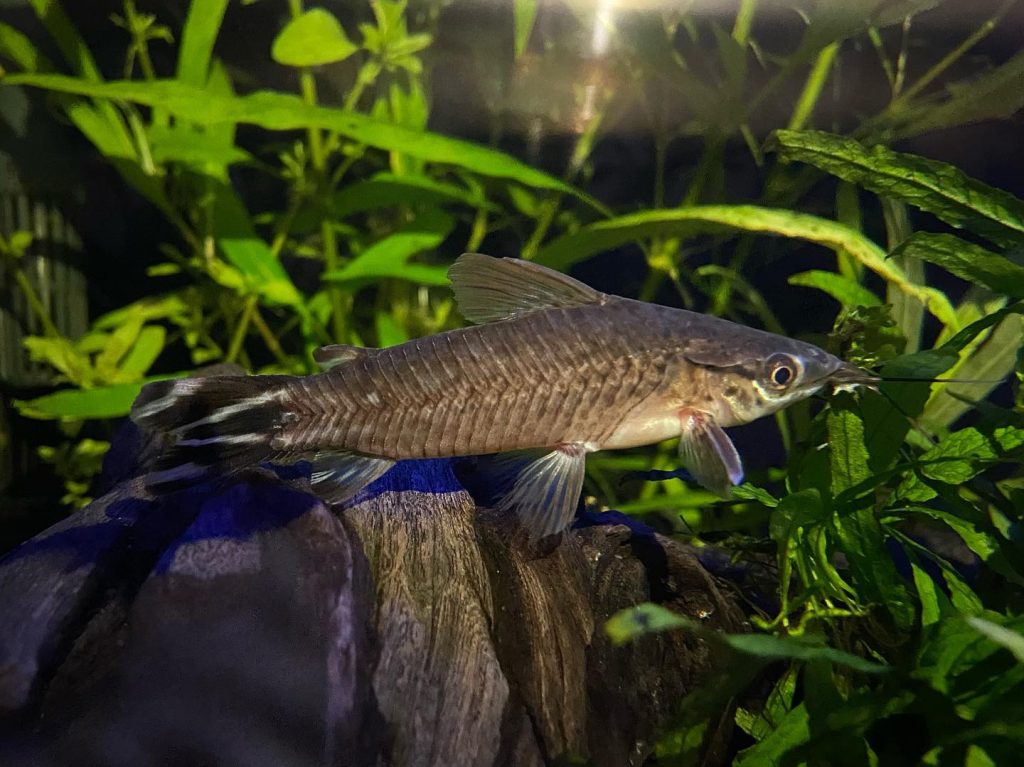
What truly captivates the observer is the Flagtail Catfish’s namesake: its caudal fin. Adorned with horizontal black and white stripes, it adds a dash of sophistication to the fish’s overall visage. Not to be overlooked are the whisker-like pairs of barbels adorning either side of its snout, which not only contribute to its characteristic catfish profile but also serve as tactile sensors. These intricate details complete the picturesque image of the Flagtail Catfish, a peaceful addition to any community aquarium.
| Distinctive Features | Description |
|---|---|
| Base Color | Grey/Brown with a silvery underside |
| Body Markings | Small black spots on the upper half |
| Sexual Dimorphism | Thickened rays in males; fuller body in females |
| Caudal Fin | Horizontal black and white stripes |
| Barbels | A pair on each side of the snout |
The visual allure of the Flagtail Catfish is undeniably unique, making it a treasured spectacle within the aquarium hobby for decades.
Behavior & Temperament
Flagtail Catfish are recognized for their peaceful nature, which makes them well-suited companions for a range of similarly sized species in a community aquarium. These bottom dwellers enjoy the midwater section of their environment and are not known to exhibit fin-nipping behavior, ensuring the safety and well-being of other aquarium inhabitants. Sociable by nature, Flagtail Catfish often display a more vibrant essence when housed in small groups.

Are Flagtail catfish Fin Nippers?
No, Flagtail Catfish are not fin nippers. Their tranquil disposition allows them to cohabit with other tankmates without causing harm to their fins. This sets them apart as desirable inhabitants in a community tank where maintaining the integrity and health of all fish is paramount.
Are Flagtail catfish Aggressive To Each Other & Other Fish?
Flagtail Catfish exhibit a non-aggressive temperament, both towards fellow catfish and other species. They can be kept with a variety of tankmates without any signs of conflict. However, more assertive and boisterous species could intimidate them, so an aquarium housing Flagtail Catfish is best populated with peaceful to semi-aggressive inhabitants.
Are Flagtail catfish Friendly To Each Other & Other Fish?
Flagtail Catfish are inherently amicable towards each other and favor the company of other non-aggressive fish. Their social nature means they can coexist harmoniously with a host of suitable tankmates such as medium-sized community fish, which includes Tetras, Rainbowfish, Rasboras, and certain types of peaceful Cichlids, Corydoras, and Loaches.
Are Flagtail catfish Schooling Fish?
Flagtail Catfish are not schooling fish and do not require the presence of a large conspecific group to thrive. While they exhibit occasional shoaling behavior, especially when kept in small groups, they typically prefer ample space to explore and are content either alone or with a few companions.
Can You Have Just One Flagtail catfish In The Tank?
While a solitary Flagtail Catfish can survive in a tank, it may not exhibit the full range of its natural behaviors. These catfish enjoy the presence of their own kind and thrive both socially and environmentally when maintained in small groups. A single Flagtail Catfish might lead a subdued existence, which could impact its overall vitality and vibrancy.
Do Flagtail catfish Need To Be In Groups?
Flagtail Catfish are socially inclined and exhibit a preference for being in groups. A grouping of four or more individuals enables them to display their shoaling behavior and interact more dynamically within their habitat, promoting a more active and engaging aquarium experience. Thus, keeping them in small groups not only mirrors their natural inclinations but also contributes to a well-balanced community tank.
Food & Diet
Flagtail Catfish boast an enthusiastic appetite and are open to a variety of food sources in their home aquariums. These fish have carnivorous leanings, meaning meaty foods are their primary dietary components. Easy-to-find choices like bloodworms, earthworms, and brine shrimp are relished by Flagtail Catfish, offering the essential nutrients these active predators need.
However, a meal plan for these catfish shouldn’t stop at live or frozen fare. To ensure a comprehensive nutritional profile, aquarists should include high-quality dried foods, such as flake or pellet options, into their diet. This diversity of food sources helps guarantee both the health and the vibrant colors of these tropical fish. Adequately feeding Flagtail Catfish involves offering meals various times a day, with portion sizes that can be consumed within a few minutes. Monitoring their overall condition and growth can then inform an ideal, sustainable feeding routine.
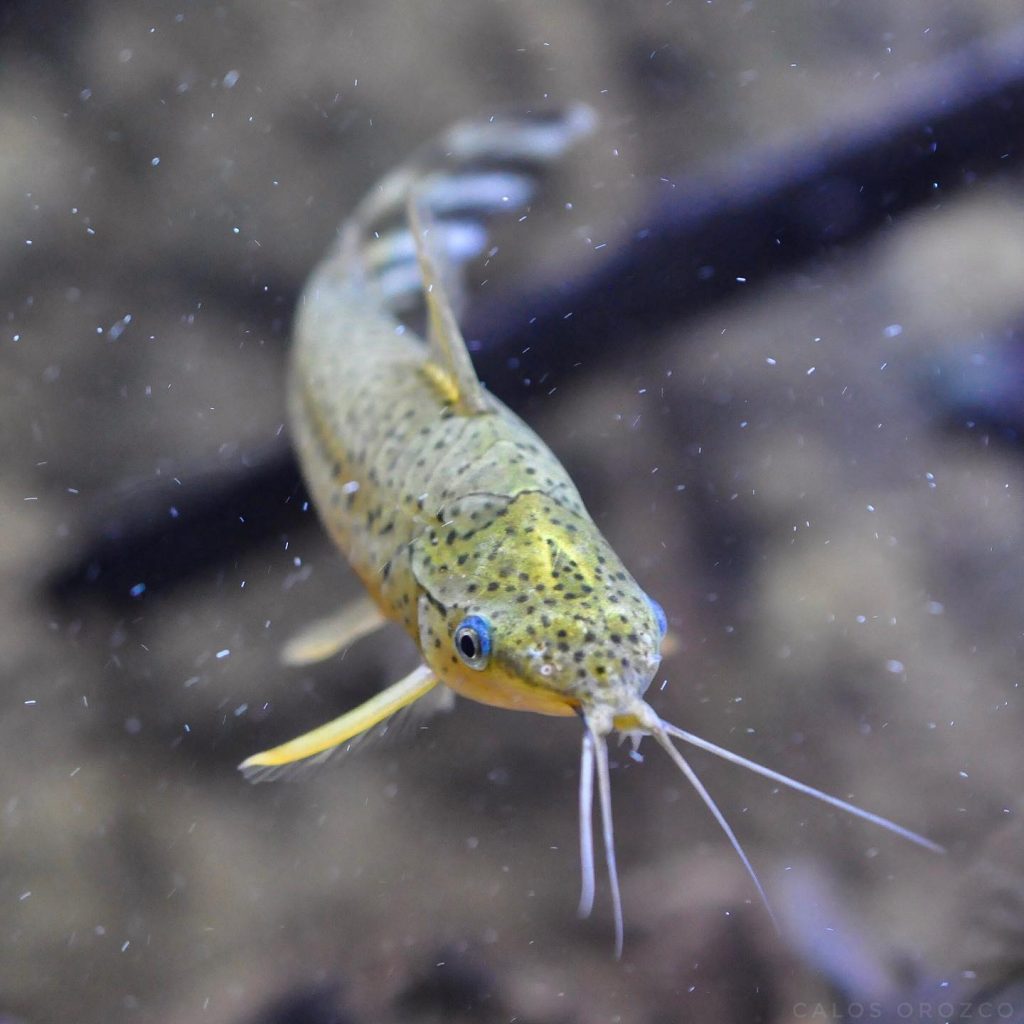
Do Flagtail catfish Eat Algae?
Although Flagtail Catfish partake in a varied diet, algae is not a significant part of their menu. While they may inadvertently ingest some as they scavenge for food across the tank’s substrate, catfish owners should focus on supplying them with their preferred meaty foods like bloodworms and chopped earthworms. Adding a touch of vegetable matter can supplement their meals, contributing to balanced nutrition. Expect these catfish to perform some tank-cleaning duties by scavenging leftovers, but don’t count on them to manage algae growth.
Do Flagtail catfish Eat Shrimp?
Certainly, shrimp is a delectable treat for Flagtail Catfish within the spectrum of their omnivorous diet. Feeding these fish includes a strong foundation of meaty foods, with shrimp offering a flavorful variation that catfish will eagerly consume. Whether it is frozen or freeze-dried, shrimp can be a staple in their diet, providing nutritional benefits and enjoyment. Regular feedings throughout the day, allowing for quick consumption, encourage their health and vitality.
Do Flagtail catfish Eat Bloodworms?
Bloodworms stand as a preferred snack for the opportunistic Flagtail Catfish. Known for their broad tastes and adaptable feeding behavior, these fish are quick to take advantage of bloodworms offered at both the surface and the bottom of the aquarium. A mix of meaty items combined with the occasional vegetable matter forms an ideal diet for these catfish, underlining their durability and suitability for a peaceful, well-planted aquarium where they can actively play a role in the ecosystem’s balance.
Do Flagtail catfish Eat Mosquito Larvae?
In their capacity as versatile eaters, Flagtail Catfish can help control unwanted pests like mosquito larvae. Their instinctual predatory habits make them efficient in this role and help maintain a more comfortable aquarium environment. Providing a mixed diet that includes bloodworms and brine shrimp can enhance essential nutrient intake while allowing them to target mosquito larvae in their habitat. Feeding them several times daily with a varied diet not only addresses their food diversity but also supports their growth and wellbeing.
Do Flagtail catfish Eat Planaria?
Flagtail Catfish, with their comprehensive appetite, will also consume small aquatic invertebrates such as planaria. The diet for these omnivores tends to focus on meaty foods, which naturally encompasses creatures like planaria found within the tank. Keeping the menu varied with quality flakes, pellets, and occasional vegetables is crucial in maintaining healthy and active Flagtail Catfish. Their ability to adapt to various food sources makes them quite adept at consuming planaria that emerge in the aquarium, contributing to their ecological utility as a species.
Do Flagtail catfish Eat Plants?
As carnivorous fish, Flagtail Catfish’s principal diet does not include plants. However, they will benefit from having vegetable matter interspersed with their meat-based meals. This does not mean that plants form a significant part of their diet, but rather serve as a supplementary source to provide a complete nutritional profile. Offering vegetable matter like blanched spinach or cucumber can add diversity to their diet. While not plant-eaters per se, the inclusion of such greenery in small quantities can aid in their health and dietary satisfaction.
Sexing: Male vs Female
Sexing Flagtail Catfish (Dianema urostriatum) is relatively straightforward due to noticeable physical differences between males and females. These distinctions become more evident as the fish reach maturity.
Male Flagtail Catfish are characterized by their thickened pectoral fin rays. These rays traverse and are more robust when compared to those of the females, making it a reliable indicator when sexing these fish. On the other hand, female Flagtail Catfish typically possess a broader and rounder body shape, especially noticeable behind the pectoral fins. This fuller physique serves as a clear visual cue to differentiate females from males.
Below is a summary of the key differences:
- Males: Thickened pectoral fin rays
- Females: Broader and rounder body shape behind pectoral fins
Even though Flagtail Catfish are not usually sold as a specific gender at fish farms, aquarists can identify the sex of their catfish by observing these unique physical traits. Understanding these distinctions is useful for breeding purposes or simply to better know the makeup of your aquarium community.
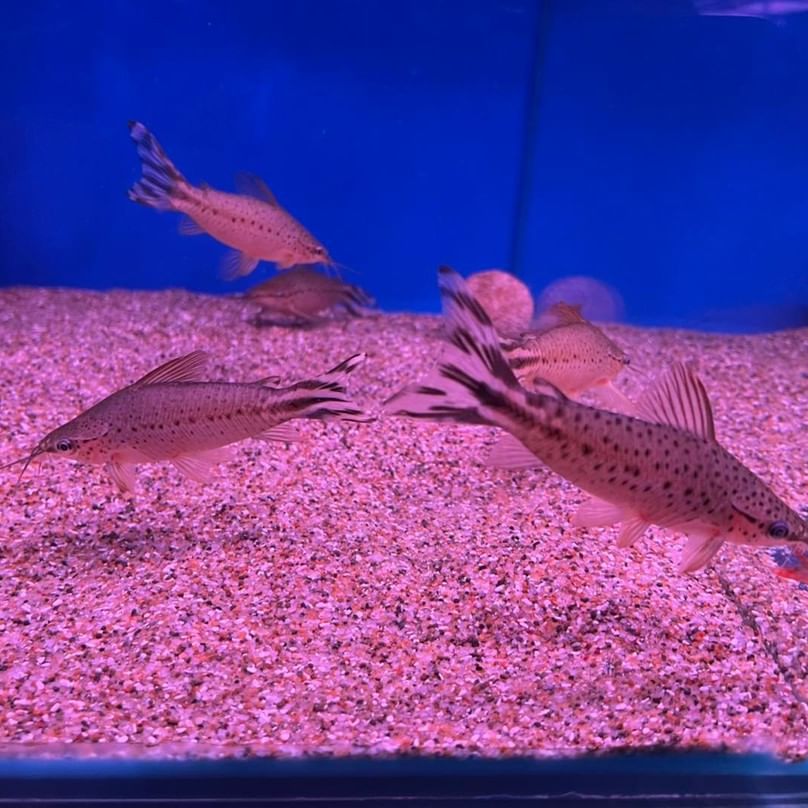
Flagtail catfish Tank Mates
The Flagtail Catfish (Dianema urostriatum) thrives in a community aquarium with a mix of peaceful to semi-aggressive tropical fish. Selecting appropriate tank mates is crucial to maintain a serene aquatic environment conducive to the well-being of your Flagtail Catfish. They are sociable creatures and fare well with fish of similar shape and size.
Here’s a concise list of suitable companions for your Flagtail Catfish:
- Medium to Large-sized Tetras: These peaceful shoaling fish complement the demeanor of the Flagtail Catfish.
- Rainbowfish: Their vibrant colors and peaceful nature make them great tank mates.
- Medium-sized Rasboras: Known for being tranquil, they can share a habitat with Flagtail Catfish harmoniously.
- Peaceful Cichlids: Opt for less territorial species to ensure a peaceful coexistence.
- Corydoras Catfish and Loaches: Their bottom-dwelling habits and peaceful temperament match well.
It is advisable to avoid larger or more aggressive species that can disrupt the tank’s harmony. To observe the natural, social interaction of Flagtail Catfish, consider keeping them in a group of five or more. This will not only enhance their comfort but also allow you to enjoy their fascinating behavior within the aquarium community.
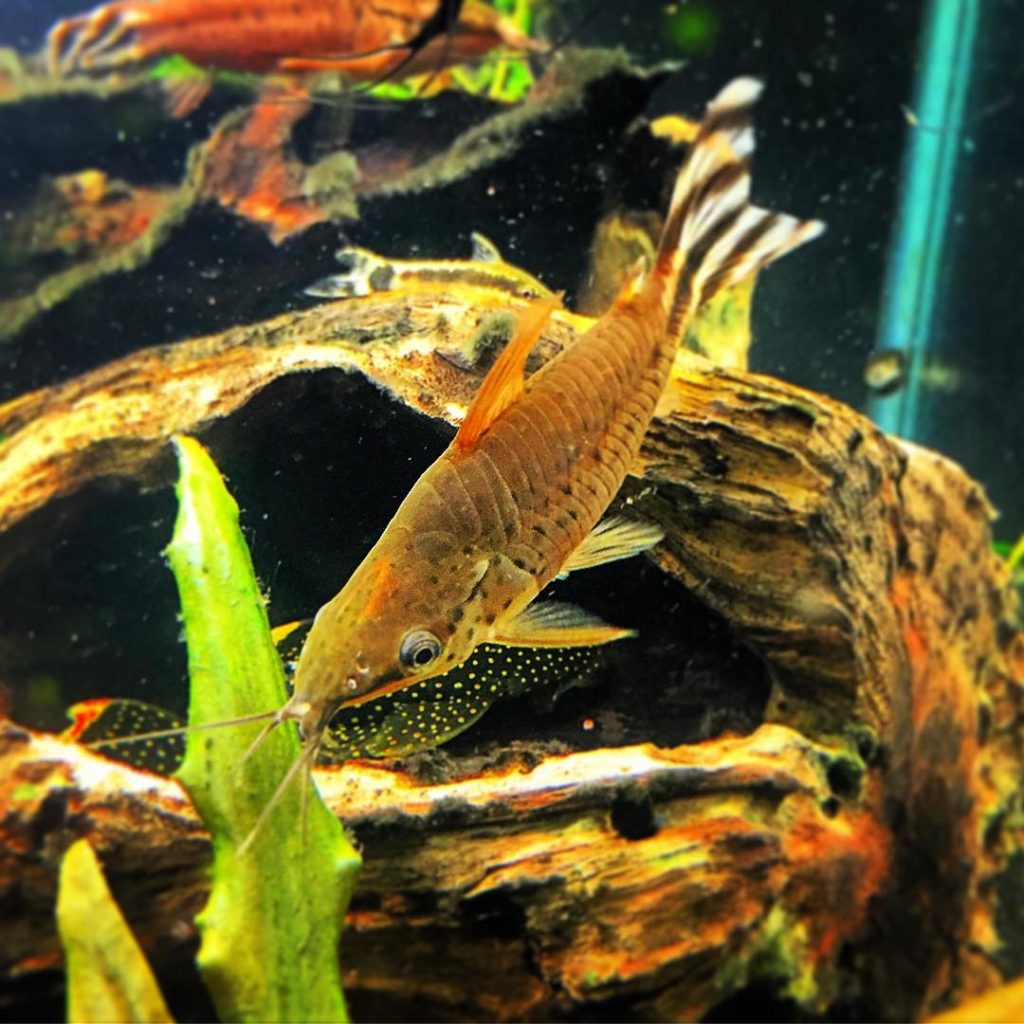
Aquarium Setup
The Flagtail Porthole Catfish, with its captivating striped tail and sociable nature, is a prized addition to many tropical freshwater aquariums. Aptly adapted to varied conditions, these catfish are relatively straightforward to care for, but setting up an optimal environment is key to their well-being. When considering an aquarium setup for the Flagtail Porthole Catfish, one must take into account the tank size, water parameters, filtration, and lighting, ensuring each aspect meets their specific needs.
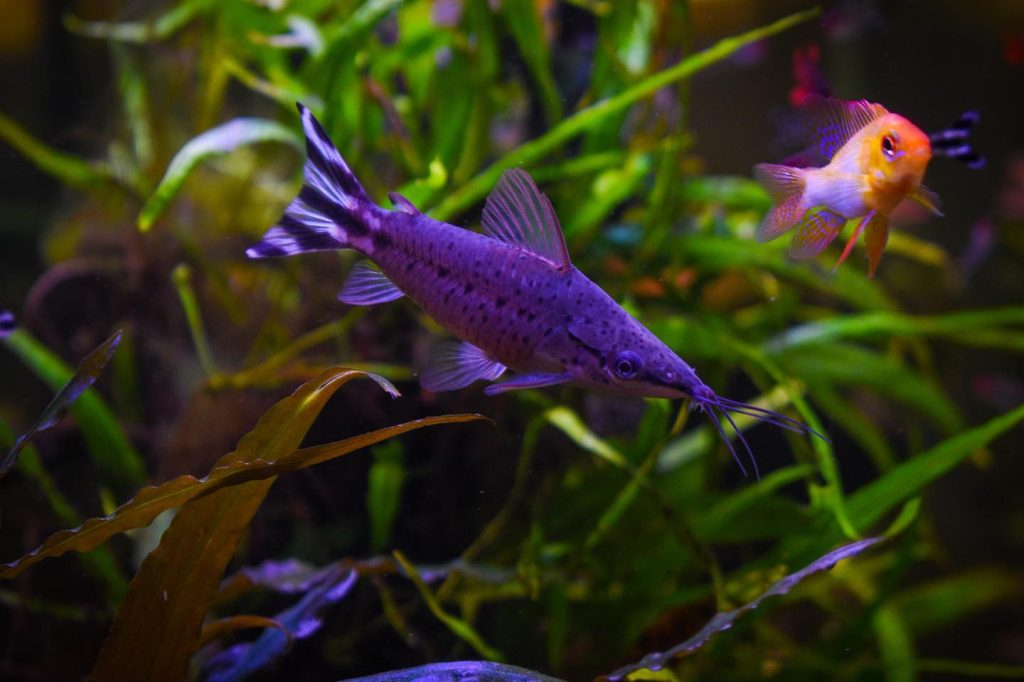
Ideal Tank Size
The recommended starting size for a tank housing Flagtail Porthole Catfish is 30 gallons. This provides ample space for these peaceful bottom-dwellers to scavenge and exhibit natural behavior, specifically if a small group is being kept together. Given their potential adult size of 5 inches, a 30-gallon tank ensures they have enough room to swim and forage without stress. A mature aquarium, free from the fluctuations of nitrite and ammonia levels, is critical, as these catfish are particularly sensitive to such changes.
Ideal Water Parameters
Creating a slice of the Amazon River basin in your home requires careful attention to the Flagtail Porthole Catfish’s water preferences. The ideal pH range is from 6.5 to 7.5, replicating the slightly acidic to neutral waters of their native habitat. Temperature is another vital parameter, with 78-82°F being the optimal range to promote the catfish’s health and vitality. Ammonia and nitrite must be kept at 0ppm, whereas nitrate levels should be maintained below 30ppm to avoid health issues in these sensitive fish. Water hardness should stay within 5 – 20 GH, which can accommodate a broad spectrum of water conditions, enhancing their adaptability in captivity.
Filtration
Efficient filtration is non-negotiable for maintaining the clarity and quality of water necessary for Flagtail Porthole Catfish. High-end power filters, canister filters, or wet/dry filters are all suitable options, as they do not demand any specific type beyond ensuring efficient cleaning and waste removal. While a robust filtration system is crucial, the water movement created by the filter should be gentle to accommodate the catfish’s preference for less turbulent waters. Maintain a regular filtration maintenance schedule to manage the accumulation of organic waste to which the Flagtail is notably sensitive.
Lighting
Flagtail Porthole Catfish favor dimly-lit environments that mimic the shaded waters of their natural habitat. However, if you wish to have a brighter tank, using floating plants to diffuse the light can create a comfortable setting for the catfish. Adding Aponogeton aquarium plants can enhance the aesthetic of the aquarium and provide cover, as they thrive in both low and moderate lighting conditions. At night, consider employing a blue moon light to observe these nocturnal creatures without disturbing their natural routines. The lighting setup, while accommodating the Flagtail’s preferences, should also consider the needs of plants and other tank inhabitants for a harmonious aquarium ecosystem.
Common Possible Diseases & Prevention
Diseases to Watch For:
- Ich (White Spot Disease): Small white spots akin to salt grains on the skin.
- Fin Rot: Tattered or disintegrating fins often with a milky edge.
- Bacterial Infections: Redness, inflammation, or ulcers on the body.
Prevention Measures:
- Water Quality: Regularly test and maintain optimal water conditions—pH, temperature, and nitrate levels—within specified ranges to prevent disease.
- Proper Diet: Feed a varied diet ensuring nutritional needs are met, helps boost the immune system. Quality flake and pellet food, along with frozen foods, should be part of their meals.
- Quarantine New Arrivals: Isolate new fish for at least 2 weeks to ensure they are disease-free before adding them to the community aquarium.
- Regular Observation: Keep a close eye on the fish’s behavior and appearance. Look for changes such as loss of appetite, abnormal swimming, or physical alterations.
- Fast Action: At the first sign of illness, quarantine affected fish and consult a veterinarian for appropriate treatment options to prevent the spread and manage recovery.
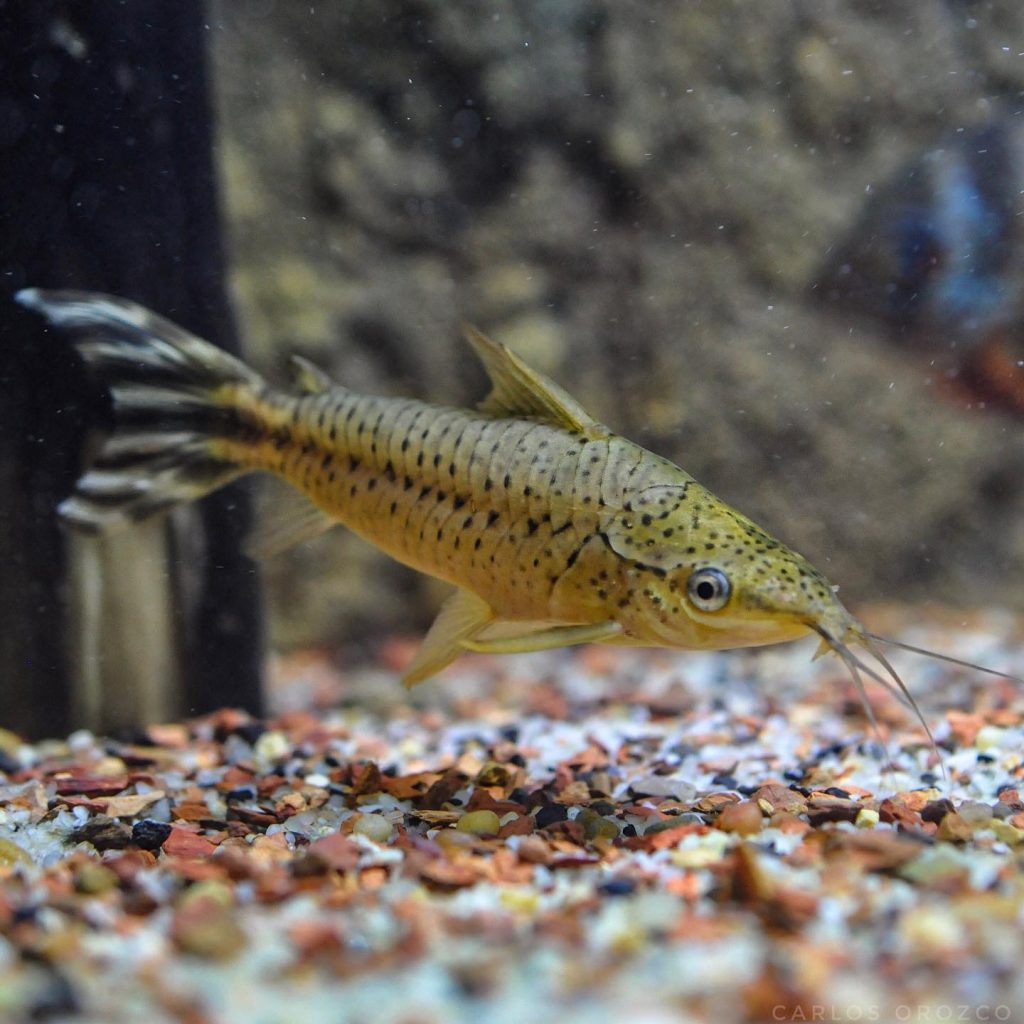
A well-managed tank where fish exhibit their natural behavior is often a healthy one. Prevention is paramount; it is easier to prevent diseases than to treat them.
Breeding Flagtail catfish In Aquarium
Breeding Flagtail Catfish in captivity can be a compelling endeavor for avid aquarium hobbyists. These tropical freshwater fish, while not extensively documented in terms of their reproductive habits, have been successfully spawned under controlled conditions.
To kickstart the breeding process, it’s advisable to start with a group of 4-6 Flagtail Catfish to increase the likelihood of pairing. To mimic their natural environment, the addition of either biodegradable materials or a suitable plastic lid on the aquarium’s surface can encourage nest construction, a critical step as they are a bubble-nesting species.
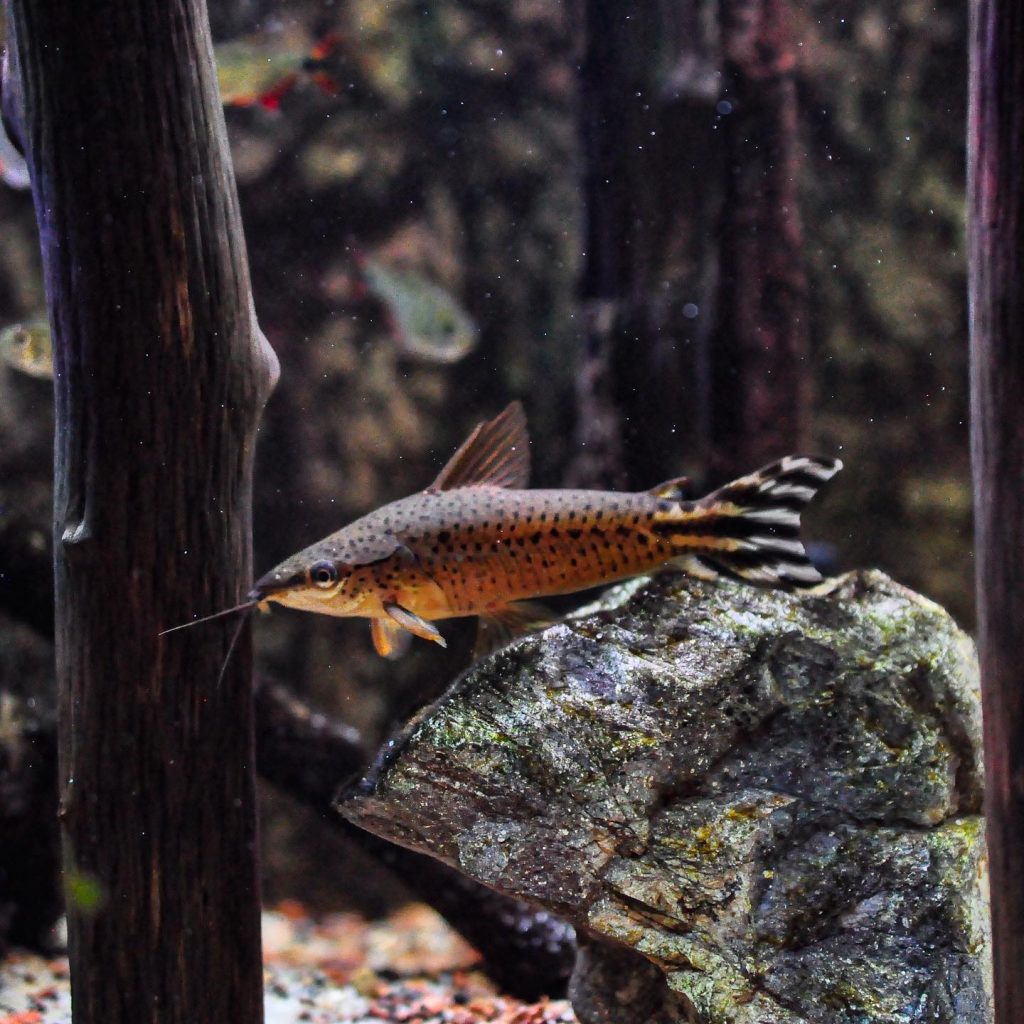
Moreover, the provision of live foods is crucial, as this not only meets their nutritional needs but can also trigger their natural breeding behaviors. Alongside this, significant water changes can further induce the spawning process.
Breeding Table:
| Requirement | Description |
|---|---|
| Initial Group Size | 4-6 individuals |
| Nesting Aids | Biodegradable materials or plastic lids |
| Diet | Abundance of live food |
| Water Management | Significant changes to stimulate breeding |
For those looking to explore the breeding intricacies of Flagtail Catfish, this promotes a stimulating and rewarding venture. As bubble-nesters, these fish will provide a unique insight into the reproductive patterns of armored catfishes.

